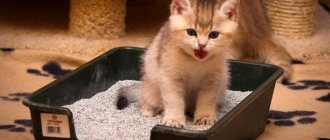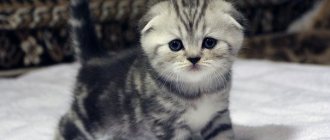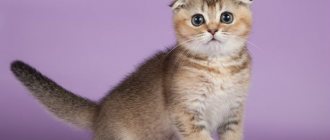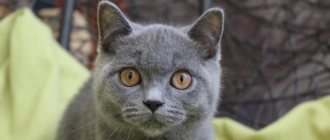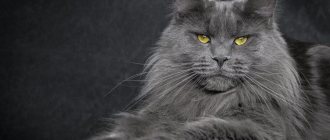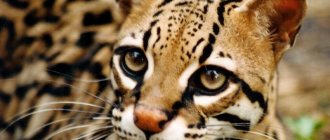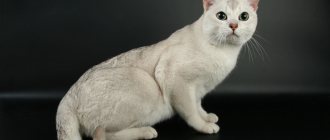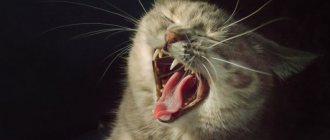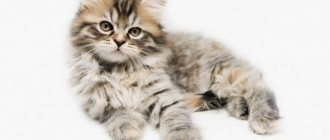If it is expensive to buy a purebred kitten, a British mixed breed will do. There are crosses between British cats and the Scottish Fold, Siamese, Persian and mongrel. The owner should know how the breeds differ, when it is possible and not recommended to cross animals. The owner must also have an idea of what a mixed breed looks like, the features of keeping, care and health of the pet.
According to felinologists, the breed combination of British and Scottish cats is meaningless, since both breeds have become independent and have an international standard. Therefore, the world associations of cat lovers banned interbreeding in 2004.
Description of breeds and differences
British and Scottish cats are very similar. However, among the British there are no cats with floppy ears. The main common features of both breeds:
- rounded head;
- round, wide eyes;
- muscular body;
- smooth transition from forehead to muzzle;
- pronounced cheeks.
The differences between the cats are as follows:
- The Scots are more graceful.
- Scottish cats have ears that are erect or drooping.
- The Scottish tail is thinner and more flexible than the British tail.
- Britons love solitude, while Scots need communication and attention.
Return to contents
Interbreeding options
Scottish and British cats were often crossed with representatives of other breeds. The kittens of some of them have received recognition from world associations of cat lovers. Others simply remained mestizos, who do not participate in breeding or exhibitions. Experimental crossbreeding of Britons and Scottish Sheeps was carried out with the following breeds:
- Siamese cat. As a result of mating Siamese with Scots, the Siafold cat breed was developed - a Siamese with hanging ears. And in 1962, it was not without the participation of a white British woman in breeding Foreign Whites - a Siamese cat of an absolutely white color.
- A cross between a British and a Persian. These cats are distinguished by their large size, rather straight nose, and long hair. Crossing a Persian Fold with a Scottish Fold is not advisable because the kittens' ears stick out to the sides rather than curling up and their fur is longer than expected.
- A cross between a British cat and a regular cat. Such a kitten has a powerful physique, but does not meet the standards of the British breed in terms of the appearance of its face, paws, tail, and colors. Such animals have no breeding value.
- A combination of British and Siberian cats. The babies contain the features of both parents, although they do not look the same in the litter. They are distinguished by an elongated muzzle, long or short hair, a mixture of colors, and large sizes. These animals can have many health problems.
Return to contents
Diversity of mestizos
All felinological associations prohibit mating between breeds. Each species has distinctive characteristics that disappear during uncontrolled reproduction. Belonging to a particular breed is determined by genotype and phenotype. That is, according to the set of genes inherited from the parents and external characteristics (body size, color, coat length, skull structure).
Maine Coon mixes
Officially, breeding Mei-Coon mixes is prohibited. In fact, there is no control over cat lovers. Unscrupulous owners cross Maine Coons with other breeds or ordinary cats. As a rule, culled individuals participate in such breeding. Serious breeders do not allow such animals to mate. Owners who purchase “defective” animals from nurseries are required to castrate or sterilize them. Large fluffy kittens are sometimes offered under the guise of purebred Maine Coons. Dishonest owners try to sell them inexpensively, explaining the discount for various reasons.
Maine Coon and Siberian cat mixes can be very beautiful
A purebred Maine Coon is expensive. Wanting to save money, cat lovers buy Maine Coon mixes in the hope that they will inherit the qualities of a purebred animal. Distinctive character traits of Maine Coon cats are:
- sociability, goodwill towards people, friendliness;
- calmness, balance;
- self-esteem;
- absence of pronounced aggressive habits;
- high level of intelligence.
In fact, a Maine Coon mixed breed cat and a purebred cat are completely different cats. Breeders worked for several decades to create and consolidate the original characteristics of the breed. Not a single mestizo will fully comply with the standards of behavior. It is impossible to predict what the character of a mature cat will be. As a result of illiterate crossbreeding, aggression may appear and poor health may occur.
British cat mixes
Uncontrolled crossing of the British cat with the Scottish Fold almost led to the degeneration of both breeds
Not everything is so simple with English cats. First of all, do not confuse the British Shorthair and the Scottish Fold. The breeds are related, but completely different. Scottish Folds (Scots) are descended from the British as a result of mutation of the ears. Strictly speaking, these are mestizos from crossing fold-eared cats with British ones. It took more than half a century for the Scottish Fold to gain independent status from a spontaneous breed.
In 2004, a ban was introduced on the crossing of Scottish Fold and British cats.
The appearance of a huge number of mestizos when crossing the British and Scots led to the gradual degeneration of both breeds. In 2004, a law was passed banning their mixing. For the same reason, in 2003 it was prohibited to cross Persian and British cats.
Mixed bengal cat
The Bengal cat is a mestizo who has become an aristocracy. This is a cross between a domestic and Asian leopard cat. To stop the barbaric export of exotic Bengals from their historical homeland, enthusiasts bred a stable breed with a wild appearance and gentle character.
Crossing Bengal cats with other breeds is prohibited by all felinological associations . Therefore, there are no officially recognized mestizos of this breed. That doesn’t stop owners who aren’t too scrupulous from pairing Bengals with other cats. As a result, smaller mixed breeds with inappropriate colors appear. The second generation completely loses the characteristics of the breed.
As a result of crossing the Bengal cat with other breeds, the characteristics of the breed are lost
Recently, the long-haired Bengal has been gaining popularity. With all the characteristics of the breed, they have long hair, a fluffy tail and a collar.
If earlier, in order to avoid damage to the breed, breeders of such kittens sterilized, now a long-haired Bengal cat is valued more than a traditional Bengal.
Persian cat mixes
Persians are considered the most common cat breed in the world. And in terms of the number of colors they have no equal. It is not surprising that there are a huge number of Persian cat mixes. The Persian-British hybrid has become widespread. A crossbreed with an ordinary domestic cat is often found. Among connoisseurs, mixed breeds of Scottish Fold (Scottish Fold) and Persian are valued.
Persian cats are used as a basis for developing new breeds
Persians are the progenitors of many cat breeds. The exotic cat is very popular. In appearance it is a Persian with short hair. Breeders do not stop there. Taking the Persian breed as a basis, they gave the world such cats as:
- Napoleon (a cross between a Persian and a Menchkin with short legs);
- Himalayan (Persian with Siamese coloring);
- Cherub (curly-haired Selkirk Rex with a Persian face);
- Tiffany (a hybrid with the Burmese breed, which has obtained unusually soft, silky wool);
- Iranian cat and Tonkaline (hybrids bred by adding genes of the Tonka breed);
- Alaskan snow cat (alliance of Somalia and White Persians).
And these are just some of the derived cat breeds.
Interspecific crossing, as a rule, does not affect the health of mixed offspring. However, there is a risk of genetic diseases.
Mixed Breeds
The Nibelung is a cross between a long-haired cat and a Russian Blue. The Nibelung's coat is soft and long. The color is only gray-blue. To produce offspring with short hair, Nibelungs are mixed with short-haired cats.
The color point color is characteristic of Siamese and Thai cats. He is dominant. To obtain it, Thais and Siamese were brought together with different cats. So, for example, we got the Neva Masquerade - a cross between a Siamese and a Siberian cat.
Is it possible to cross breeds?
When is breeding possible?
Folds no longer mate with Scots. However, sometimes this is necessary to improve the color or gain new features in appearance. Experimental matings are carried out, and the litter is carefully studied by specialists. Interbreed mating is undesirable, since the standard characteristics are lost, and the babies may develop joint problems in the future.
When is breeding prohibited?
The Fold cat can only mate with Scottish cats with straight ears due to a gene that lowers the ear flaps. Only one carrier of such a gene is allowed in a couple, otherwise the offspring will die or have severe genetic abnormalities. There is no ban among the British. Only cats with deviations from the standard - malocclusion, squint, or creases in the tail - are not allowed for breeding.
When is it possible to crossbreed a Briton and a Scot?
You can match a Brit with a Scot when:
- it is necessary to bring out new features in appearance;
- improve color.
Such matings are called experimental and are carried out in a nursery under the supervision of specialists who carefully study the litter.
Since during cross-breed mating, babies lose standard traits and have problems with the musculoskeletal system, cat owners are not advised to mate animals of the same breed.
What does a mestizo look like?
Half-breeds contain the features of both parents, so their appearance allows for any deviations. The main external data of a mixture of British and Scots is shown in the table:
| Part of the body | Characteristic |
| Torso | Powerful, stocky, rough |
| Head | Round, large |
| The nose is straight, the transition from the forehead to the muzzle is noticeable | |
| Developed chin | |
| Ears | Pyramidal, erect |
| Incomplete forward fold in those who have the gene for lop ears | |
| Paws | Powerful, thick, rounded pads |
| Eyes | Round, wide open |
| Any shade, colors can be mixed | |
| Tail | Elongated, thick |
| Wool | Short, thick, tight-fitting |
| There is undercoat | |
| Color | Plain, mostly blue or tabby pattern |
Return to contents
Photo gallery of mixed-breed cats
When crossing Persian and Siberian cats, you get cute mestizos
It is difficult to determine from the appearance of a kitten which breed characteristics will prevail in the future.
Mixed breeds with the Marquis phenotype have an even, predictable character
Multi-colored mestizos are believed to bring good luck
What is the health of a half-breed cat?
Mixing breeds leads to genetic or acquired diseases. The following deviations may be observed in a mestizo:
- Inflammation of the joints. The Scottish woman has a weak ligamentous apparatus, while the British woman is distinguished by wide bones and a powerful body. Interbreed mixture leads to arthritis, due to which the cat moves little, experiences severe pain, and its limbs are deformed.
- Kidney diseases. Metis are prone to obesity, which negatively affects the urinary system. Therefore, the animal runs the risk of developing urolithiasis or pyelonephritis, which can become chronic.
- Ear diseases. The lop ear gene affects the ear cartilage, so your cat may have ear pain. Constant scratching with paws leads to secondary infection and inflammation.
Return to contents
Maintenance and care
Mixed breeds should be cared for in the same way as other cats. Brush should be done at least once a week with combs for short-haired cats. The tray should be spacious and filled with bentonite or wood. It is necessary to feed the cat with high-quality holistic, super or premium food - “Bozita”, “Farmina”, “Acana”, “Trainer”, “Pronature”, “Origin”. The diet should include lean meat, greens, low-fat cottage cheese, and hard-boiled eggs. Ears and eyes should be cleaned every week with special animal products “Beafar”, “Trixie”, “Bars”. Teeth require daily care with Dentavedin, Nutri-Vet, and Zubastik products. You should bathe your cat only when dirty. To prevent dangerous infections, your pet should be vaccinated in a timely manner.
Among the many existing cat breeds, mestizos occupy their niche. They are the result of crossing different cats. Among the mixed breeds of elite breeds, a mixture of British and Scots is popular.
About crossing two breeds
Those who want to get a pet that combines the qualities of 2 breeds they like often do not know whether they can be crossed. Experienced breeders take into account the genotypes of cats before breeding a new species.
The British Fold cat is not a cross between a British and a Scottish cat, it does not exist. Mating of the British Shorthair cat breed with the Scottish Fold is strictly prohibited.
Until 2004, British and Scottish shorthair cats were bred, which were used to breed the Scottish Fold or the Scottish Straight and Scottish Fold cats.
Since lop-earedness is caused by a mutating gene, crossing two lop-eared Scots is not allowed due to the risk of fatal diseases in the offspring and genetic deformities.
To comply with breed standards, Scottish Folds and Scottish Straights are bred together, and the same is done with the British.
Interbreeding is undesirable and has been officially prohibited since 2004 by the World Cat Federation (WCF).
British Shorthair cat: description of the breed in accordance with the standard
The search for a thoroughbred Briton begins with familiarization with the requirements of the standards. We must, in the end, imagine what exactly we are looking for in order to weed out all those kittens that cunning businessmen are trying to sell to the ignorant as a Briton, a mixed-breed Briton, a Briton without documents (“His mom and dad are elite-class Britons, honestly , just an unplanned mating!”), a cross between a British cat and an ordinary cat.
The head of a true Briton
So, as the British say, “the breed is in the head.” For the cat breed called "British" this statement is literally true. Their head should be massive, round and located on a short, strong neck. It is important to make one clarification. A round head shape is common to many breeds. The difference between the classic British is a convex, rounded forehead, which goes into the back of the head in a smooth line, and between the ears there is an almost flat area. At the same time, both male and female cats have pronounced cheeks, there is a chin, and the nose is short, wide, straight, without a “stop”.
Beginners often ask the question of what a “stop” is, which a thoroughbred Briton should not have. The easiest way to see this sign is in Persians and exotics. Look at the profile photo of these breeds: between the line of the nose and forehead at eye level there is a pronounced dimple, a sharp transition; If you try to draw a line with your finger, your hand will involuntarily stop. This is “stop”. So, the British nose goes into the forehead without a break, in a smooth line.
Ears are another feature of British cats. They must be small, and this applies not only to adults, but also to kittens. So if the seller assures you. That the proportions will change with age - make no mistake: burdocks will remain burdocks. A purebred British kitten has small, neat ears in the most tender childhood and during the period of teenage awkwardness. But too close placement in kittens improves a little with age. The size of the head increases and the ears move apart a little further.
Another note about the ears concerns a breed called the “British Fold”, which some so-called “breeders” still offer for purchase. Please note that the standard does not provide for the creases on the ears of cats of the British breed, which give a touching appearance to their Scottish “colleagues”. Read more...
Huge, round, widely spaced eyes give British kittens a special charm. Even mature, respectable cats look cute thanks to their eyes. And again, the kitten’s eyes grow proportionally, so the hope that the eyes will become larger with age is very illusory, since the muzzle will also grow. Coquettishly raised corners of the eyes may look charming, but... For a purebred British cat, this is unacceptable. The eye color of kittens is almost always blue or close to it, and with age it changes in accordance with the color.
Bones and physique
The British - both male and female cats - are quite large, with strong bones and a short, strong neck. However, the specificity of the British breed is that the animal develops quite slowly, fully gaining adult “conditions” only by the age of three. At the same time, kittens of different breed lines can develop unevenly, at different speeds. Some kittens at 4-5 months and even older (and it is at this age that good breeders usually actively offer them for sale) often look like awkward ugly ducklings. Some people's legs stretch out, and the back ones may seem longer than the front ones, while others have an incredibly small head. In general, from small fluffy two-month-old charmers, these babies turn into strange creatures that look like tramps. Do not be upset if a similar metamorphosis occurs with the cat you chose at a tender age and refuse to purchase a pet. After all, it won’t take long for the pet to level out. By the age of one year, the cat will become very similar to its worthy ancestors. And in a couple of years he can get a bunch of titles at exhibitions. And even if you are not interested in an exhibition career, you will still be proud of the huge plush Briton.
When choosing a kitten, experts advise paying attention, first of all, to its chest. This is where the future physique is most revealing. The chest should be wide, and the bones themselves should be thick enough. For comparison, look at the photo and “touch” several kittens of the same age - the difference is quite obvious even to a non-specialist.
The legs of a purebred kitten of the British breed, like those of an adult animal, should be short and strong, and the paws should be round and massive.
In general, little Britons resemble cute bear cubs - well-fed, round-headed, with thick paws and a short tail like a carrot. Moreover, this “carrot” should not be the classic one – triangular – but with a blunt rounded tip. An important detail is that the kitten’s tail should not be looked at, but felt, since its thickness should be determined not by the thick fur, but by the caudal vertebrae themselves.
The fur of a British cat
The main thing you need to know about the coat of British cats is that it should be short and have a very thick undercoat. When examining the litter, pay attention that the kitten should not have guard hairs sticking out above the undercoat. Otherwise, these hairs will later create excess fur length.
If you are interested in British cats, the description of the breed includes possible colors. However, in this case it is almost impossible to describe all the nuances of colors in one general article. The number of colors exceeds a dozen. Monochromatic, patterned, and point colors are allowed. Smoky and chinchilla British cats are very beautiful. The fashion for colors changes over time and often even depends on popular films in which British cats appear. For example, the popular “Whiskas” color became widely known due to the advertising of the food of the same name. Experts call this color black marble on silver.
When choosing a British kitten, you should pay attention to the color of its parents. So, if you want to get a pet with a beautiful bright pattern, then it is better to choose a baby from two patterned parents. In this case, there is a higher probability that the child will inherit good contrast, and the drawing will appear in all its glory. Same with monochromatic ones. It is better if both parents are monochromatic, otherwise in adulthood there is a risk of a ghostly, barely noticeable pattern appearing.
In general, it must be said that here, too, the British mature slowly - and the color fully “flourishes” only after 10 months of age. This especially applies to patterned kittens.
Correct content
When purchasing a cat, you need to immediately determine in what conditions you plan to keep it: exclusively indoors or with access to the street. The best option is when your pet is adapted to different environments.
If the cat is used to constantly being indoors, then it is better not to start walking it, and if necessary, to be examined by a veterinarian, carry it in a carrier. Otherwise, it can lead to stress for the animal.
Your pet should have its own bowls, bed, tray, scratching post, and comb. It is recommended to place the sleeping place and tray in quiet places where no one will disturb him.
Pet care
Proper care guarantees a healthy and long life for your pet. Its basis is proper nutrition and hygiene.
Cats are carnivorous animals, so animal food must be present in the diet. Kittens need to be fed 5-6 times, and from one year onwards 2-3 times a day. Cats do not have enzymes that help them absorb fiber, so flour products and fruits should not be fed, and vegetables are allowed in small quantities.
When calculating daily food intake, you need to take into account the breed, sex and age of the animal, and also alternate natural products with dry and wet food. Food should be at room temperature, and water should always be clean and available.
Hygienic coat care is simple, but requires frequency. Combing at least once a week with special massage brushes. If your cat has long hair, you need to brush it daily.
At the same time, do not forget to examine the ears and eyes. Trim your nails once a month. Prevention against worms is carried out once every 3 months, even if the pet is not walked outside. It is necessary to undergo an annual examination of the general health of the veterinarian and promptly vaccinate the animal.
Owner reviews
Reviews from owners of both purebred cats and mixed breeds will always be different, even if we are talking about the same breed. This is due to the fact that each animal has its own character, formed under the influence of various circumstances.
However, thanks to the words of the owners, it is possible to determine which traits are most inherent in the breed.
Metis, that is, a cross between two different breeds, is an unpredictable creature, because its genes can appear in the most unexpected combinations. Sometimes they turn out to be successful (for example, a softer character or good health appears), sometimes they are undesirable. Let's see what the consequences are and what kittens are born from two different breeds.
Attention! Information about the possible origin of the mestizos presented in the article is approximate, because without having documents for the cat, it is impossible to say what breed it is. Roots can only be determined approximately by eye. Therefore, if we say that a given cat is a Scots-Persian mix, then there is no 100% guarantee that this is really the case. However, these cats look exactly like mixtures of these breeds.
British and Scottish cat mix
Most often you can find a mixture of British and Scots. It’s not even entirely appropriate to call them a mestizo of the British and Scots, because... According to some felinological systems, it is allowed to record such a litter as purebred Scots. Previously, such matings were generally carried out often and were a variant of the norm, because The Scottish breed at the first stages was obtained, among other things, from crossings with the British. But now the breed is established and does not need such matings. With proper crossbreeding, a cat that is a mixture of a Scotsman and a Briton can look very impressive. But this doesn't happen so often.
Basically, from the crossing of British and Scots, either defective individuals are born, or with insufficiently expressed breed qualities. In addition, a cross between a British and a Scot may have musculoskeletal problems.
President of the International Feline Association Elena Shevchenko
For a long time, the process of selecting couples was not regulated in any way. As a result, a significant number of straights of completely different types were obtained. Matings with the British breed result in British-type straight cats - rather heavy, squat, with a round head, a short thick tail, almost corresponding to the standard of a British cat. Matings with medium-type British dogs and other straights result in straights of “no type” - stretched out, the head is not round enough, the tail is long, the legs are high, the eyes are deep set. According to breed standards, the advantages of a British cat are the disadvantages of a Scottish cat. As a result of such matings, the type of both the British and the Scottish type deteriorated.
However, kittens resulting from the mating of a British and a Scot are considered a Scottish breed. It is recorded in documents, because, for example, the WCF rules do not prohibit crossing the British with the Scots. However, such litter cannot be recorded as British.
The emergence and development of the British cat breed
The history of the “British” begins in the 19th century, when the first standards for short-haired cats of the “English type” were created. Back then, these large, powerful animals with rounded shapes and harmonious proportions often won first places at exhibitions. However, with the advent of new breeds - long-haired Persians, exquisite Orientals, dazzling white, silky long-haired Angoras - the British gradually faded into the background. Although lovers of this breed continued breeding work.
Thanks to enthusiasts, the breed was preserved until the beginning of World War II. Military actions not only distract the attention of the mass audience from pets. Bombings lead to the death of a large number of breeding animals, and some of them, left without owners, run wild or die, unable to adapt to a half-starved wandering existence.
In the post-war years, breeders discovered that the number of purebred British cats and male cats was catastrophically small for breeding work. Moreover, this is the situation not only in our native Britain, but throughout Europe. And then, to increase the population and reduce inbreeding, the British begin to be bred with Persians, European shorthair cats, and Russian blues. Uncontrolled matings caused the British standard to become blurred. The bones became thinner, the heads of some representatives of the breed lost their perfectly rounded shape, and the hair became less thick; animals with longer hair than required by the standard began to appear.
Purposeful selection work is still aimed precisely at making the British more uniform, recognizable precisely due to their bone structure, physique and quality of wool, because the breed has a wide variety of colors, which means color cannot be considered decisive.
The 70-80s in Europe and the United States are characterized by the emergence of a massive middle class. Wealthy people can afford to purchase purebred cats, which was previously considered only the privilege of the elite. And there is a need for a breed that is easy to keep, calm, so that the pet can spend most of the day alone while the owners work. At the same time, the breed must be friendly, healthy and at the same time look well-groomed with minimal effort and time. Thoroughbred British dogs perfectly meet all these criteria. It was the demand that ensured the real “boom” of the British breed at the end of the 20th century, which covered most countries not only in Western but also in Eastern Europe.
The first British came to Russia from Czechoslovakia. And in the 90s, the breed was actively gaining popularity. I really liked the massive, well-fed, plush cats with round eyes. They fit into the ideal of a pet and allowed them to feel like they belonged to the “elite”. The British are winning first places at numerous exhibitions, specialized clubs and communities of amateurs are appearing. Did this benefit the breed? Not really. Of course, a whole cohort of professional breeders has appeared in Russia who are conducting targeted breeding work and developing new colors. Breed diseases are carefully monitored.
And at the same time, increased demand led to the emergence of “specialists” who put British breeding on stream. Entire houses and apartments, where there are several floors of cages with animals that are more or less similar to British cats. Fictitious clubs that draw fictitious documents. And now advertisements like “purebred British kittens inexpensively” appear all around. A person who is far from breeding does not even understand that a purebred kitten simply cannot cost 5-7 thousand rubles, since such an amount does not even pay for its maintenance. A lot has been written about the risk of buying such kittens.
At the same time, inexperienced breeders, even with the best intentions, begin to uncontrollably breed their pets, finding partners through advertisements, without understanding anything about the genetics of colors and the transmission of breed characteristics. This has led to the fact that the British phenotype is now partially lost, and only a specialist who is well versed in all breed lines can purchase a truly thoroughbred show-class animal.
